Report: Implementing an Employee Change Management Plan at Kennigo
VerifiedAdded on 2021/02/20
|11
|2858
|37
Report
AI Summary
This report presents an employee change management plan designed for Kennigo Social House, a restaurant facing workplace issues due to interpersonal conflicts among staff. The plan addresses the need for change, strategy implementation, and the use of Kotter's 8-step model to improve the organizational structure. The report analyzes the workplace issues, and proposes a shift from a flat to a divisional organizational structure to reduce conflicts and promote skill-sharing. It details each step of Kotter's model, including establishing urgency, forming a coalition, creating a vision, communicating the vision, empowering people, creating short-term wins, building on the change, and making it stick. The report emphasizes the importance of continuous improvement through review, revision, and effective communication strategies to ensure that changes are successfully implemented and maintained within the organization. The goal is to enhance employee engagement, improve customer service, and foster a positive work environment.

Employee Change
Management Plan
Management Plan
Paraphrase This Document
Need a fresh take? Get an instant paraphrase of this document with our AI Paraphraser
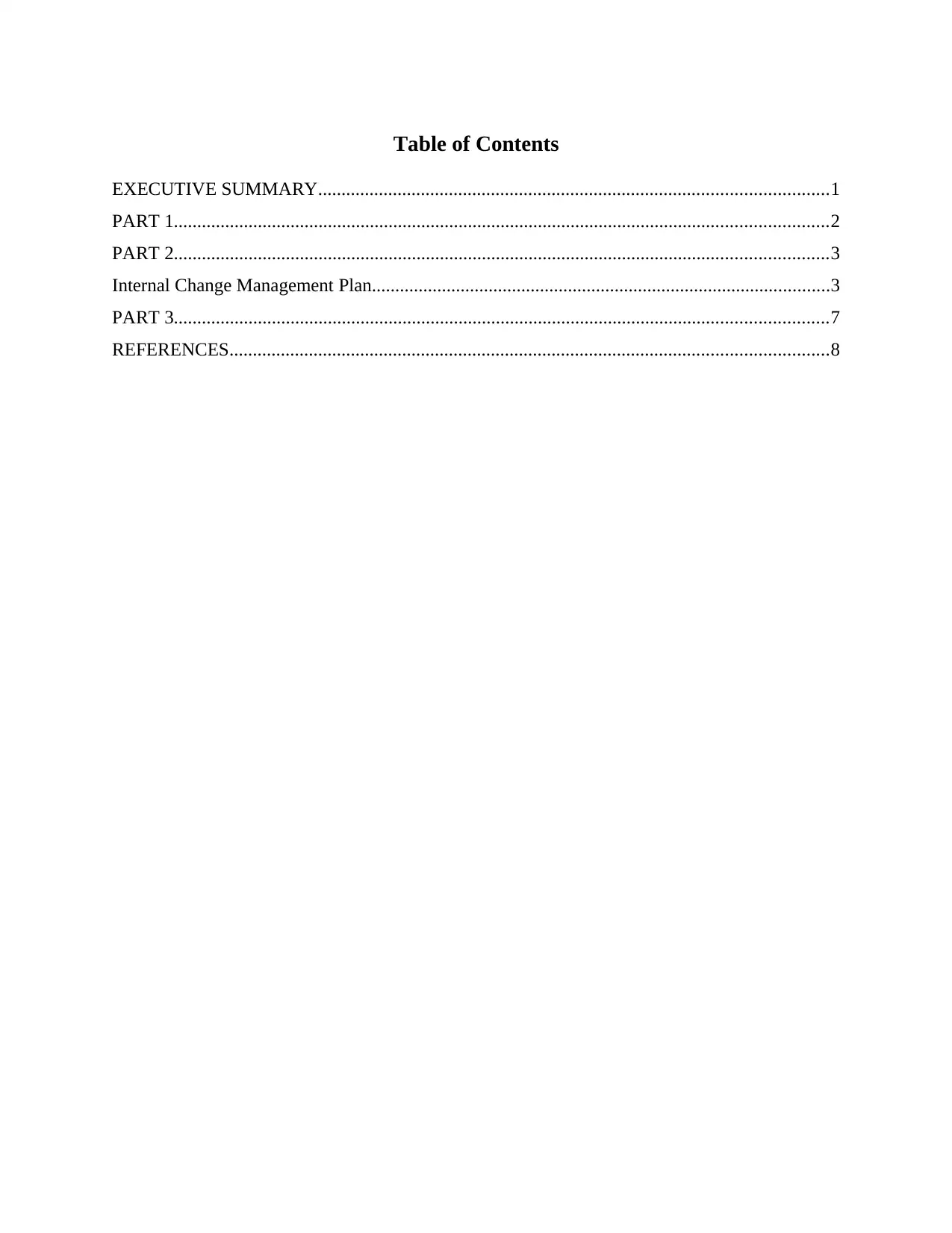
Table of Contents
EXECUTIVE SUMMARY.............................................................................................................1
PART 1............................................................................................................................................2
PART 2............................................................................................................................................3
Internal Change Management Plan..................................................................................................3
PART 3............................................................................................................................................7
REFERENCES................................................................................................................................8
EXECUTIVE SUMMARY.............................................................................................................1
PART 1............................................................................................................................................2
PART 2............................................................................................................................................3
Internal Change Management Plan..................................................................................................3
PART 3............................................................................................................................................7
REFERENCES................................................................................................................................8

⊘ This is a preview!⊘
Do you want full access?
Subscribe today to unlock all pages.

Trusted by 1+ million students worldwide
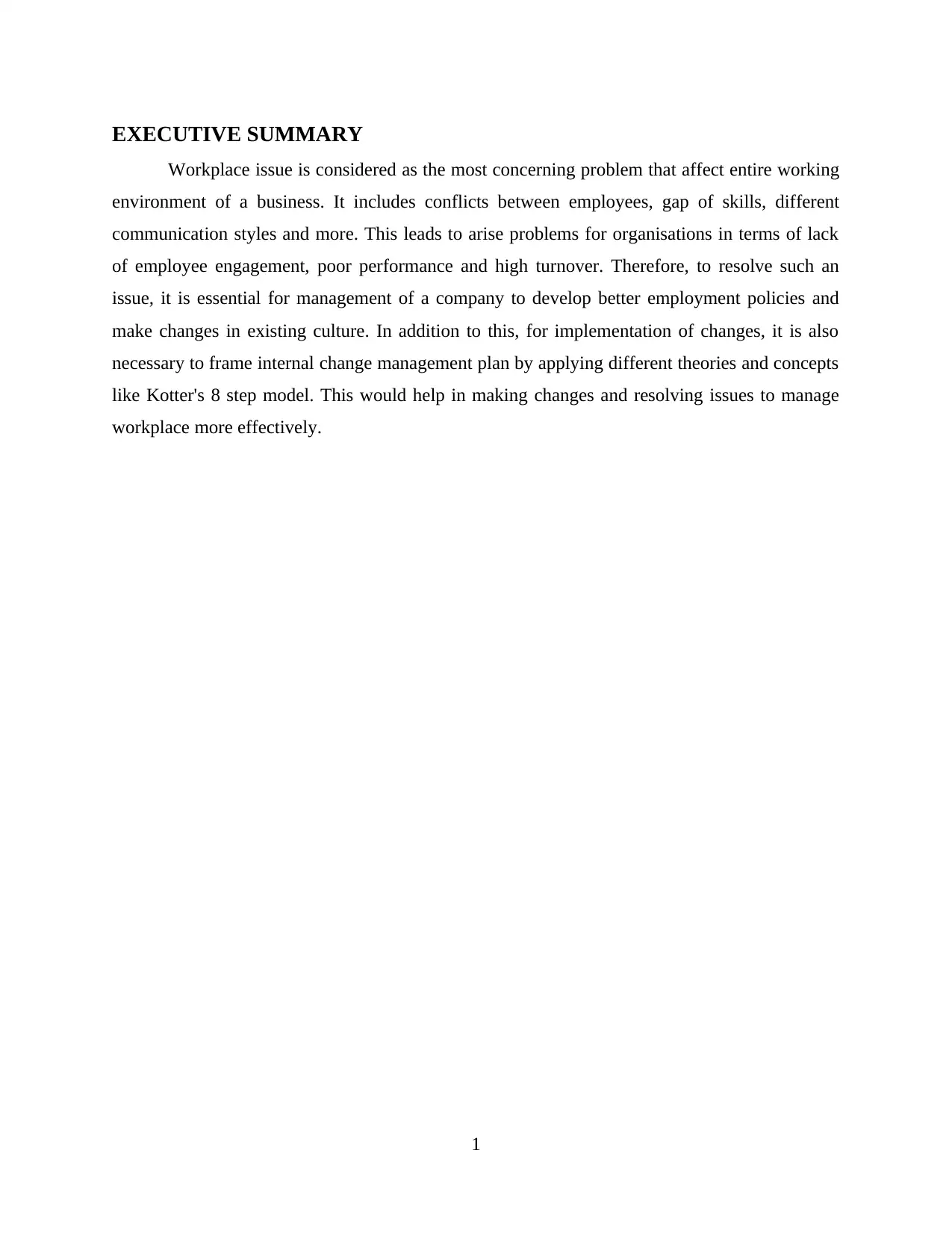
EXECUTIVE SUMMARY
Workplace issue is considered as the most concerning problem that affect entire working
environment of a business. It includes conflicts between employees, gap of skills, different
communication styles and more. This leads to arise problems for organisations in terms of lack
of employee engagement, poor performance and high turnover. Therefore, to resolve such an
issue, it is essential for management of a company to develop better employment policies and
make changes in existing culture. In addition to this, for implementation of changes, it is also
necessary to frame internal change management plan by applying different theories and concepts
like Kotter's 8 step model. This would help in making changes and resolving issues to manage
workplace more effectively.
1
Workplace issue is considered as the most concerning problem that affect entire working
environment of a business. It includes conflicts between employees, gap of skills, different
communication styles and more. This leads to arise problems for organisations in terms of lack
of employee engagement, poor performance and high turnover. Therefore, to resolve such an
issue, it is essential for management of a company to develop better employment policies and
make changes in existing culture. In addition to this, for implementation of changes, it is also
necessary to frame internal change management plan by applying different theories and concepts
like Kotter's 8 step model. This would help in making changes and resolving issues to manage
workplace more effectively.
1
Paraphrase This Document
Need a fresh take? Get an instant paraphrase of this document with our AI Paraphraser
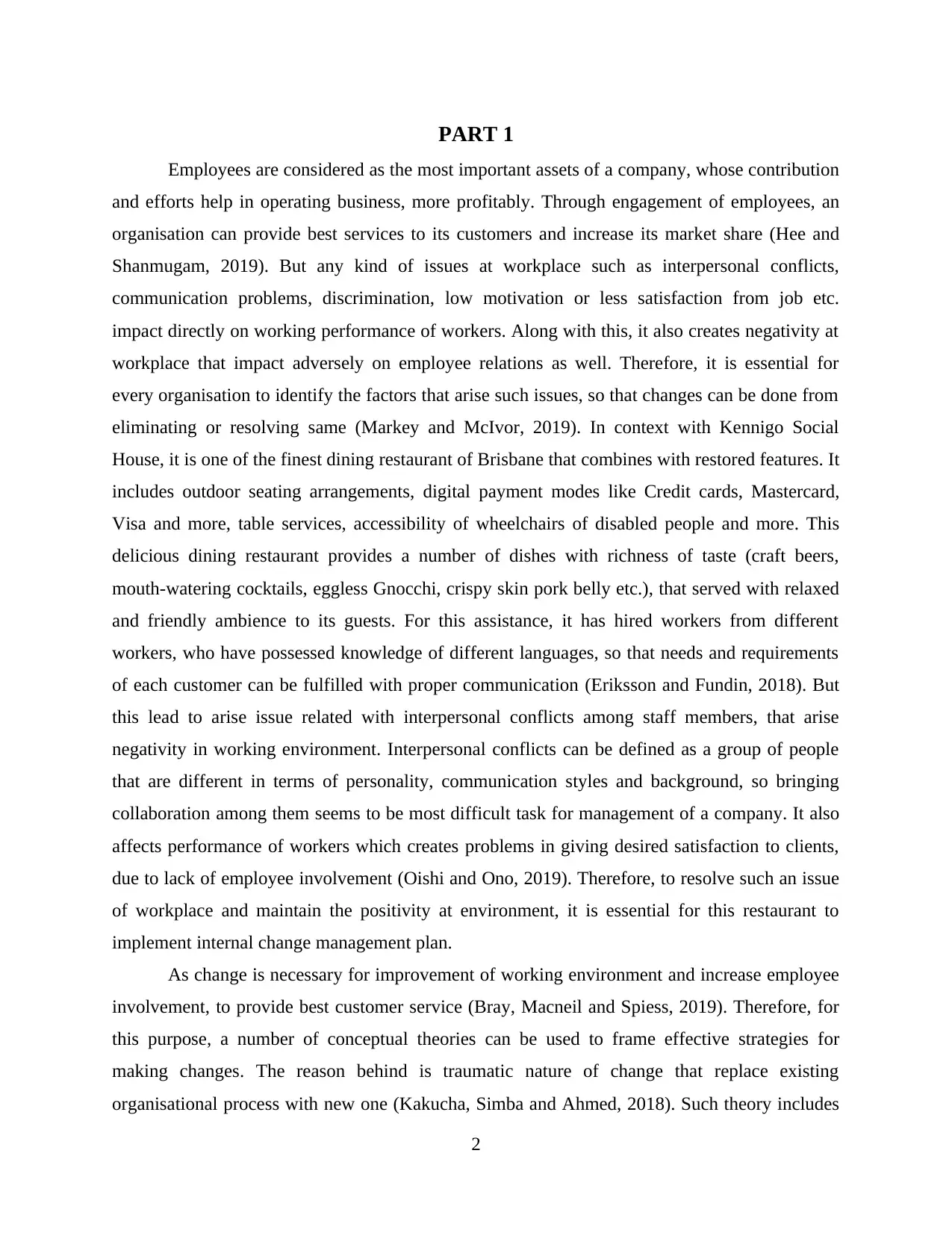
PART 1
Employees are considered as the most important assets of a company, whose contribution
and efforts help in operating business, more profitably. Through engagement of employees, an
organisation can provide best services to its customers and increase its market share (Hee and
Shanmugam, 2019). But any kind of issues at workplace such as interpersonal conflicts,
communication problems, discrimination, low motivation or less satisfaction from job etc.
impact directly on working performance of workers. Along with this, it also creates negativity at
workplace that impact adversely on employee relations as well. Therefore, it is essential for
every organisation to identify the factors that arise such issues, so that changes can be done from
eliminating or resolving same (Markey and McIvor, 2019). In context with Kennigo Social
House, it is one of the finest dining restaurant of Brisbane that combines with restored features. It
includes outdoor seating arrangements, digital payment modes like Credit cards, Mastercard,
Visa and more, table services, accessibility of wheelchairs of disabled people and more. This
delicious dining restaurant provides a number of dishes with richness of taste (craft beers,
mouth-watering cocktails, eggless Gnocchi, crispy skin pork belly etc.), that served with relaxed
and friendly ambience to its guests. For this assistance, it has hired workers from different
workers, who have possessed knowledge of different languages, so that needs and requirements
of each customer can be fulfilled with proper communication (Eriksson and Fundin, 2018). But
this lead to arise issue related with interpersonal conflicts among staff members, that arise
negativity in working environment. Interpersonal conflicts can be defined as a group of people
that are different in terms of personality, communication styles and background, so bringing
collaboration among them seems to be most difficult task for management of a company. It also
affects performance of workers which creates problems in giving desired satisfaction to clients,
due to lack of employee involvement (Oishi and Ono, 2019). Therefore, to resolve such an issue
of workplace and maintain the positivity at environment, it is essential for this restaurant to
implement internal change management plan.
As change is necessary for improvement of working environment and increase employee
involvement, to provide best customer service (Bray, Macneil and Spiess, 2019). Therefore, for
this purpose, a number of conceptual theories can be used to frame effective strategies for
making changes. The reason behind is traumatic nature of change that replace existing
organisational process with new one (Kakucha, Simba and Ahmed, 2018). Such theory includes
2
Employees are considered as the most important assets of a company, whose contribution
and efforts help in operating business, more profitably. Through engagement of employees, an
organisation can provide best services to its customers and increase its market share (Hee and
Shanmugam, 2019). But any kind of issues at workplace such as interpersonal conflicts,
communication problems, discrimination, low motivation or less satisfaction from job etc.
impact directly on working performance of workers. Along with this, it also creates negativity at
workplace that impact adversely on employee relations as well. Therefore, it is essential for
every organisation to identify the factors that arise such issues, so that changes can be done from
eliminating or resolving same (Markey and McIvor, 2019). In context with Kennigo Social
House, it is one of the finest dining restaurant of Brisbane that combines with restored features. It
includes outdoor seating arrangements, digital payment modes like Credit cards, Mastercard,
Visa and more, table services, accessibility of wheelchairs of disabled people and more. This
delicious dining restaurant provides a number of dishes with richness of taste (craft beers,
mouth-watering cocktails, eggless Gnocchi, crispy skin pork belly etc.), that served with relaxed
and friendly ambience to its guests. For this assistance, it has hired workers from different
workers, who have possessed knowledge of different languages, so that needs and requirements
of each customer can be fulfilled with proper communication (Eriksson and Fundin, 2018). But
this lead to arise issue related with interpersonal conflicts among staff members, that arise
negativity in working environment. Interpersonal conflicts can be defined as a group of people
that are different in terms of personality, communication styles and background, so bringing
collaboration among them seems to be most difficult task for management of a company. It also
affects performance of workers which creates problems in giving desired satisfaction to clients,
due to lack of employee involvement (Oishi and Ono, 2019). Therefore, to resolve such an issue
of workplace and maintain the positivity at environment, it is essential for this restaurant to
implement internal change management plan.
As change is necessary for improvement of working environment and increase employee
involvement, to provide best customer service (Bray, Macneil and Spiess, 2019). Therefore, for
this purpose, a number of conceptual theories can be used to frame effective strategies for
making changes. The reason behind is traumatic nature of change that replace existing
organisational process with new one (Kakucha, Simba and Ahmed, 2018). Such theory includes
2
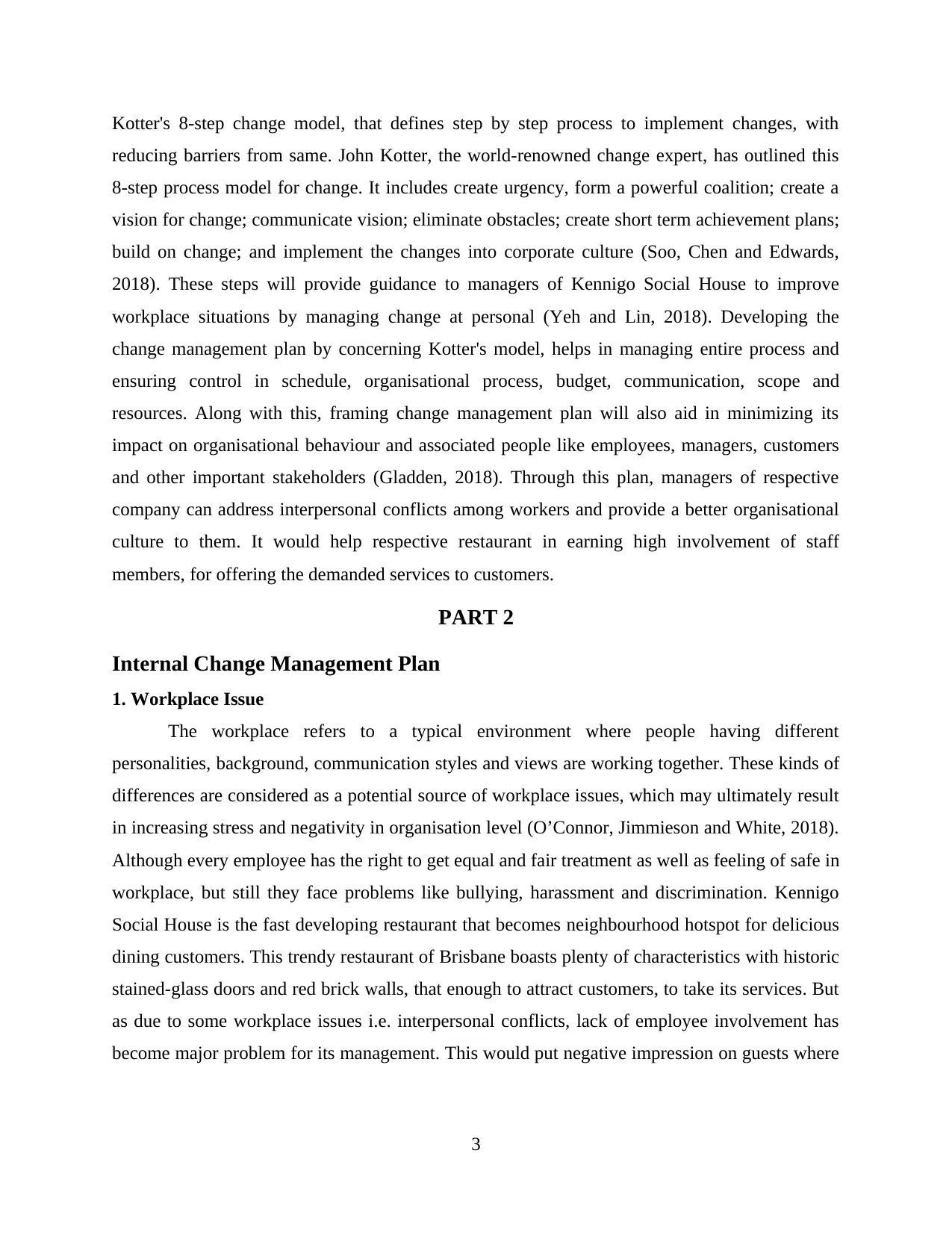
Kotter's 8-step change model, that defines step by step process to implement changes, with
reducing barriers from same. John Kotter, the world-renowned change expert, has outlined this
8-step process model for change. It includes create urgency, form a powerful coalition; create a
vision for change; communicate vision; eliminate obstacles; create short term achievement plans;
build on change; and implement the changes into corporate culture (Soo, Chen and Edwards,
2018). These steps will provide guidance to managers of Kennigo Social House to improve
workplace situations by managing change at personal (Yeh and Lin, 2018). Developing the
change management plan by concerning Kotter's model, helps in managing entire process and
ensuring control in schedule, organisational process, budget, communication, scope and
resources. Along with this, framing change management plan will also aid in minimizing its
impact on organisational behaviour and associated people like employees, managers, customers
and other important stakeholders (Gladden, 2018). Through this plan, managers of respective
company can address interpersonal conflicts among workers and provide a better organisational
culture to them. It would help respective restaurant in earning high involvement of staff
members, for offering the demanded services to customers.
PART 2
Internal Change Management Plan
1. Workplace Issue
The workplace refers to a typical environment where people having different
personalities, background, communication styles and views are working together. These kinds of
differences are considered as a potential source of workplace issues, which may ultimately result
in increasing stress and negativity in organisation level (O’Connor, Jimmieson and White, 2018).
Although every employee has the right to get equal and fair treatment as well as feeling of safe in
workplace, but still they face problems like bullying, harassment and discrimination. Kennigo
Social House is the fast developing restaurant that becomes neighbourhood hotspot for delicious
dining customers. This trendy restaurant of Brisbane boasts plenty of characteristics with historic
stained-glass doors and red brick walls, that enough to attract customers, to take its services. But
as due to some workplace issues i.e. interpersonal conflicts, lack of employee involvement has
become major problem for its management. This would put negative impression on guests where
3
reducing barriers from same. John Kotter, the world-renowned change expert, has outlined this
8-step process model for change. It includes create urgency, form a powerful coalition; create a
vision for change; communicate vision; eliminate obstacles; create short term achievement plans;
build on change; and implement the changes into corporate culture (Soo, Chen and Edwards,
2018). These steps will provide guidance to managers of Kennigo Social House to improve
workplace situations by managing change at personal (Yeh and Lin, 2018). Developing the
change management plan by concerning Kotter's model, helps in managing entire process and
ensuring control in schedule, organisational process, budget, communication, scope and
resources. Along with this, framing change management plan will also aid in minimizing its
impact on organisational behaviour and associated people like employees, managers, customers
and other important stakeholders (Gladden, 2018). Through this plan, managers of respective
company can address interpersonal conflicts among workers and provide a better organisational
culture to them. It would help respective restaurant in earning high involvement of staff
members, for offering the demanded services to customers.
PART 2
Internal Change Management Plan
1. Workplace Issue
The workplace refers to a typical environment where people having different
personalities, background, communication styles and views are working together. These kinds of
differences are considered as a potential source of workplace issues, which may ultimately result
in increasing stress and negativity in organisation level (O’Connor, Jimmieson and White, 2018).
Although every employee has the right to get equal and fair treatment as well as feeling of safe in
workplace, but still they face problems like bullying, harassment and discrimination. Kennigo
Social House is the fast developing restaurant that becomes neighbourhood hotspot for delicious
dining customers. This trendy restaurant of Brisbane boasts plenty of characteristics with historic
stained-glass doors and red brick walls, that enough to attract customers, to take its services. But
as due to some workplace issues i.e. interpersonal conflicts, lack of employee involvement has
become major problem for its management. This would put negative impression on guests where
3
⊘ This is a preview!⊘
Do you want full access?
Subscribe today to unlock all pages.

Trusted by 1+ million students worldwide
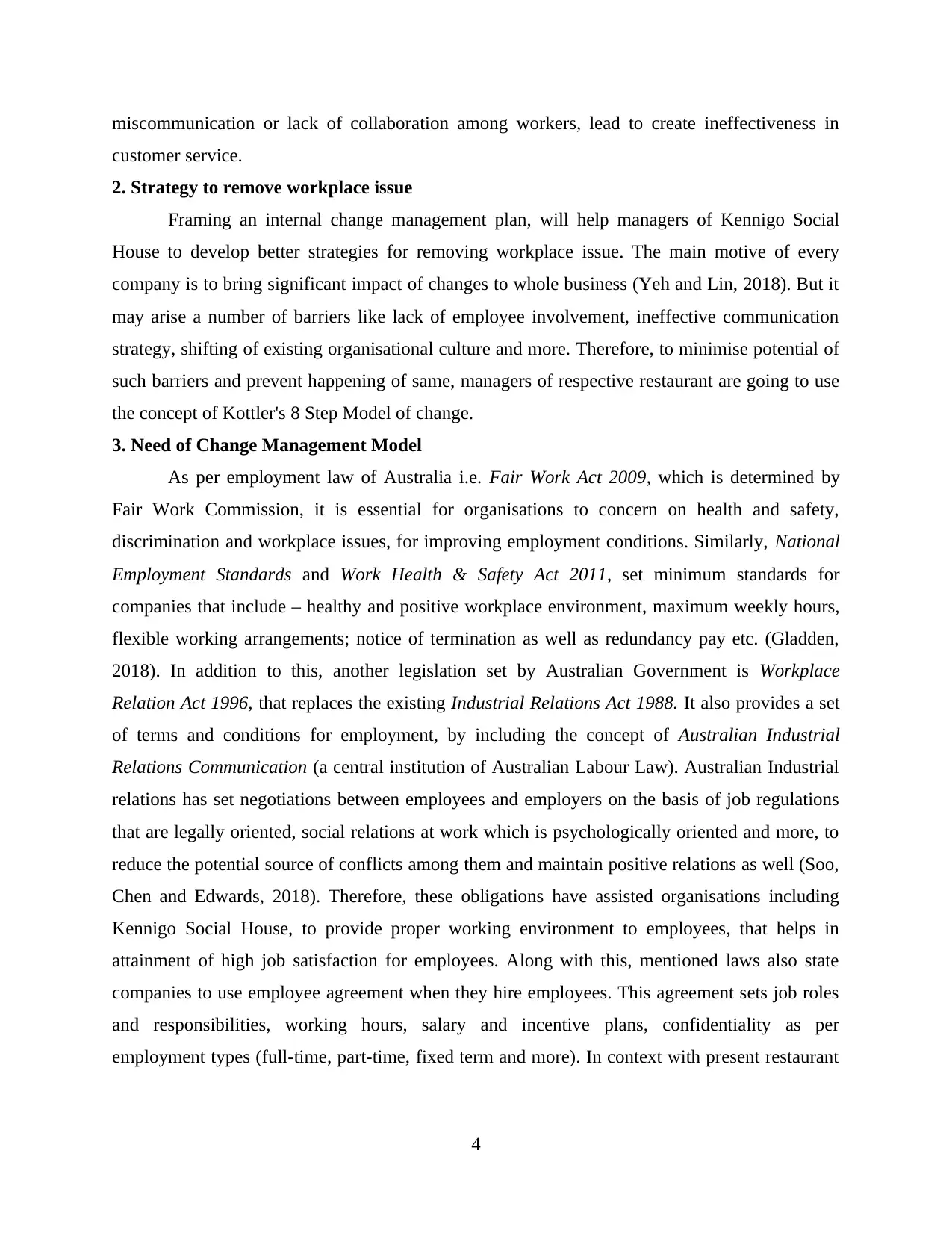
miscommunication or lack of collaboration among workers, lead to create ineffectiveness in
customer service.
2. Strategy to remove workplace issue
Framing an internal change management plan, will help managers of Kennigo Social
House to develop better strategies for removing workplace issue. The main motive of every
company is to bring significant impact of changes to whole business (Yeh and Lin, 2018). But it
may arise a number of barriers like lack of employee involvement, ineffective communication
strategy, shifting of existing organisational culture and more. Therefore, to minimise potential of
such barriers and prevent happening of same, managers of respective restaurant are going to use
the concept of Kottler's 8 Step Model of change.
3. Need of Change Management Model
As per employment law of Australia i.e. Fair Work Act 2009, which is determined by
Fair Work Commission, it is essential for organisations to concern on health and safety,
discrimination and workplace issues, for improving employment conditions. Similarly, National
Employment Standards and Work Health & Safety Act 2011, set minimum standards for
companies that include – healthy and positive workplace environment, maximum weekly hours,
flexible working arrangements; notice of termination as well as redundancy pay etc. (Gladden,
2018). In addition to this, another legislation set by Australian Government is Workplace
Relation Act 1996, that replaces the existing Industrial Relations Act 1988. It also provides a set
of terms and conditions for employment, by including the concept of Australian Industrial
Relations Communication (a central institution of Australian Labour Law). Australian Industrial
relations has set negotiations between employees and employers on the basis of job regulations
that are legally oriented, social relations at work which is psychologically oriented and more, to
reduce the potential source of conflicts among them and maintain positive relations as well (Soo,
Chen and Edwards, 2018). Therefore, these obligations have assisted organisations including
Kennigo Social House, to provide proper working environment to employees, that helps in
attainment of high job satisfaction for employees. Along with this, mentioned laws also state
companies to use employee agreement when they hire employees. This agreement sets job roles
and responsibilities, working hours, salary and incentive plans, confidentiality as per
employment types (full-time, part-time, fixed term and more). In context with present restaurant
4
customer service.
2. Strategy to remove workplace issue
Framing an internal change management plan, will help managers of Kennigo Social
House to develop better strategies for removing workplace issue. The main motive of every
company is to bring significant impact of changes to whole business (Yeh and Lin, 2018). But it
may arise a number of barriers like lack of employee involvement, ineffective communication
strategy, shifting of existing organisational culture and more. Therefore, to minimise potential of
such barriers and prevent happening of same, managers of respective restaurant are going to use
the concept of Kottler's 8 Step Model of change.
3. Need of Change Management Model
As per employment law of Australia i.e. Fair Work Act 2009, which is determined by
Fair Work Commission, it is essential for organisations to concern on health and safety,
discrimination and workplace issues, for improving employment conditions. Similarly, National
Employment Standards and Work Health & Safety Act 2011, set minimum standards for
companies that include – healthy and positive workplace environment, maximum weekly hours,
flexible working arrangements; notice of termination as well as redundancy pay etc. (Gladden,
2018). In addition to this, another legislation set by Australian Government is Workplace
Relation Act 1996, that replaces the existing Industrial Relations Act 1988. It also provides a set
of terms and conditions for employment, by including the concept of Australian Industrial
Relations Communication (a central institution of Australian Labour Law). Australian Industrial
relations has set negotiations between employees and employers on the basis of job regulations
that are legally oriented, social relations at work which is psychologically oriented and more, to
reduce the potential source of conflicts among them and maintain positive relations as well (Soo,
Chen and Edwards, 2018). Therefore, these obligations have assisted organisations including
Kennigo Social House, to provide proper working environment to employees, that helps in
attainment of high job satisfaction for employees. Along with this, mentioned laws also state
companies to use employee agreement when they hire employees. This agreement sets job roles
and responsibilities, working hours, salary and incentive plans, confidentiality as per
employment types (full-time, part-time, fixed term and more). In context with present restaurant
4
Paraphrase This Document
Need a fresh take? Get an instant paraphrase of this document with our AI Paraphraser
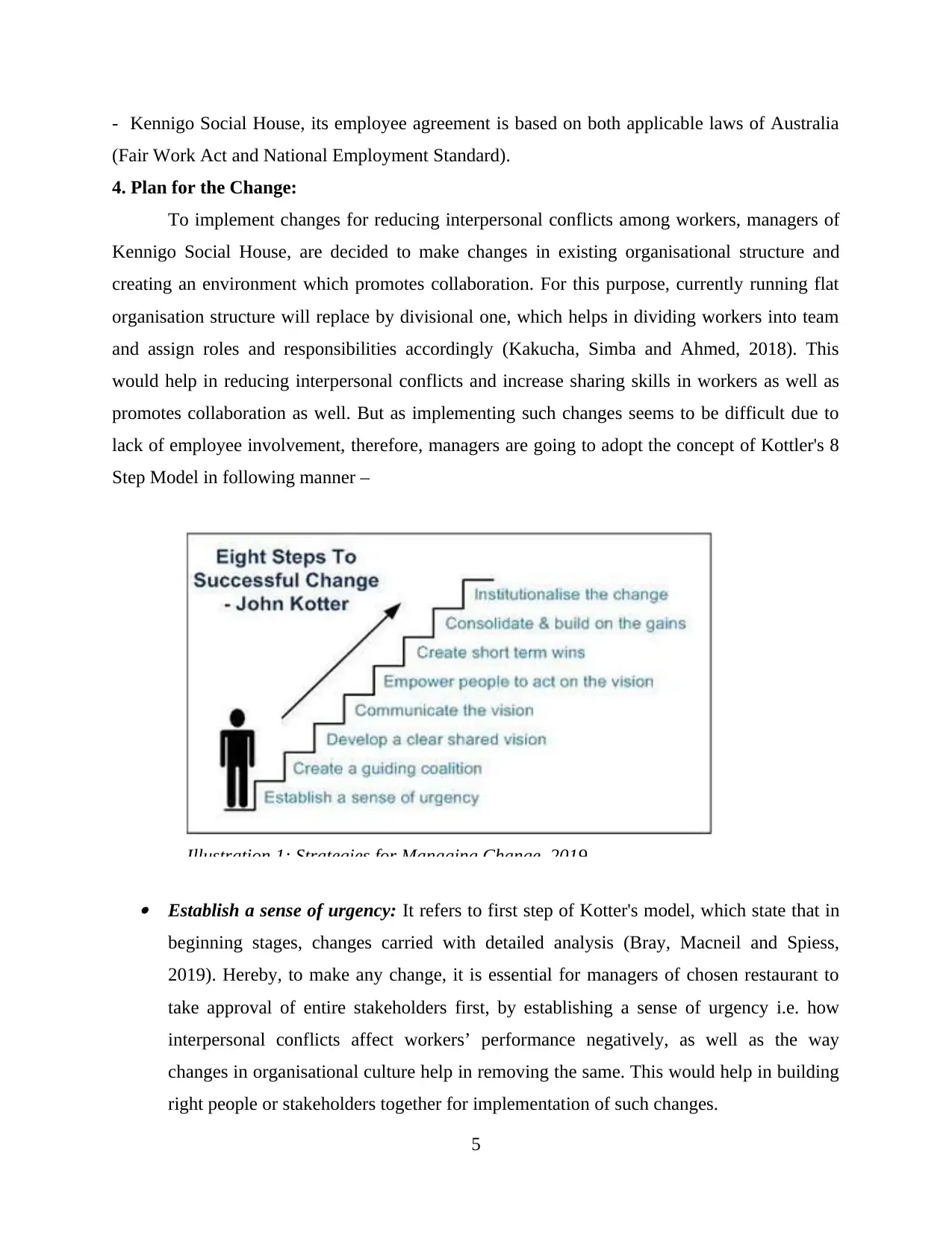
- Kennigo Social House, its employee agreement is based on both applicable laws of Australia
(Fair Work Act and National Employment Standard).
4. Plan for the Change:
To implement changes for reducing interpersonal conflicts among workers, managers of
Kennigo Social House, are decided to make changes in existing organisational structure and
creating an environment which promotes collaboration. For this purpose, currently running flat
organisation structure will replace by divisional one, which helps in dividing workers into team
and assign roles and responsibilities accordingly (Kakucha, Simba and Ahmed, 2018). This
would help in reducing interpersonal conflicts and increase sharing skills in workers as well as
promotes collaboration as well. But as implementing such changes seems to be difficult due to
lack of employee involvement, therefore, managers are going to adopt the concept of Kottler's 8
Step Model in following manner –
Establish a sense of urgency: It refers to first step of Kotter's model, which state that in
beginning stages, changes carried with detailed analysis (Bray, Macneil and Spiess,
2019). Hereby, to make any change, it is essential for managers of chosen restaurant to
take approval of entire stakeholders first, by establishing a sense of urgency i.e. how
interpersonal conflicts affect workers’ performance negatively, as well as the way
changes in organisational culture help in removing the same. This would help in building
right people or stakeholders together for implementation of such changes.
5
Illustration 1: Strategies for Managing Change, 2019
(Fair Work Act and National Employment Standard).
4. Plan for the Change:
To implement changes for reducing interpersonal conflicts among workers, managers of
Kennigo Social House, are decided to make changes in existing organisational structure and
creating an environment which promotes collaboration. For this purpose, currently running flat
organisation structure will replace by divisional one, which helps in dividing workers into team
and assign roles and responsibilities accordingly (Kakucha, Simba and Ahmed, 2018). This
would help in reducing interpersonal conflicts and increase sharing skills in workers as well as
promotes collaboration as well. But as implementing such changes seems to be difficult due to
lack of employee involvement, therefore, managers are going to adopt the concept of Kottler's 8
Step Model in following manner –
Establish a sense of urgency: It refers to first step of Kotter's model, which state that in
beginning stages, changes carried with detailed analysis (Bray, Macneil and Spiess,
2019). Hereby, to make any change, it is essential for managers of chosen restaurant to
take approval of entire stakeholders first, by establishing a sense of urgency i.e. how
interpersonal conflicts affect workers’ performance negatively, as well as the way
changes in organisational culture help in removing the same. This would help in building
right people or stakeholders together for implementation of such changes.
5
Illustration 1: Strategies for Managing Change, 2019
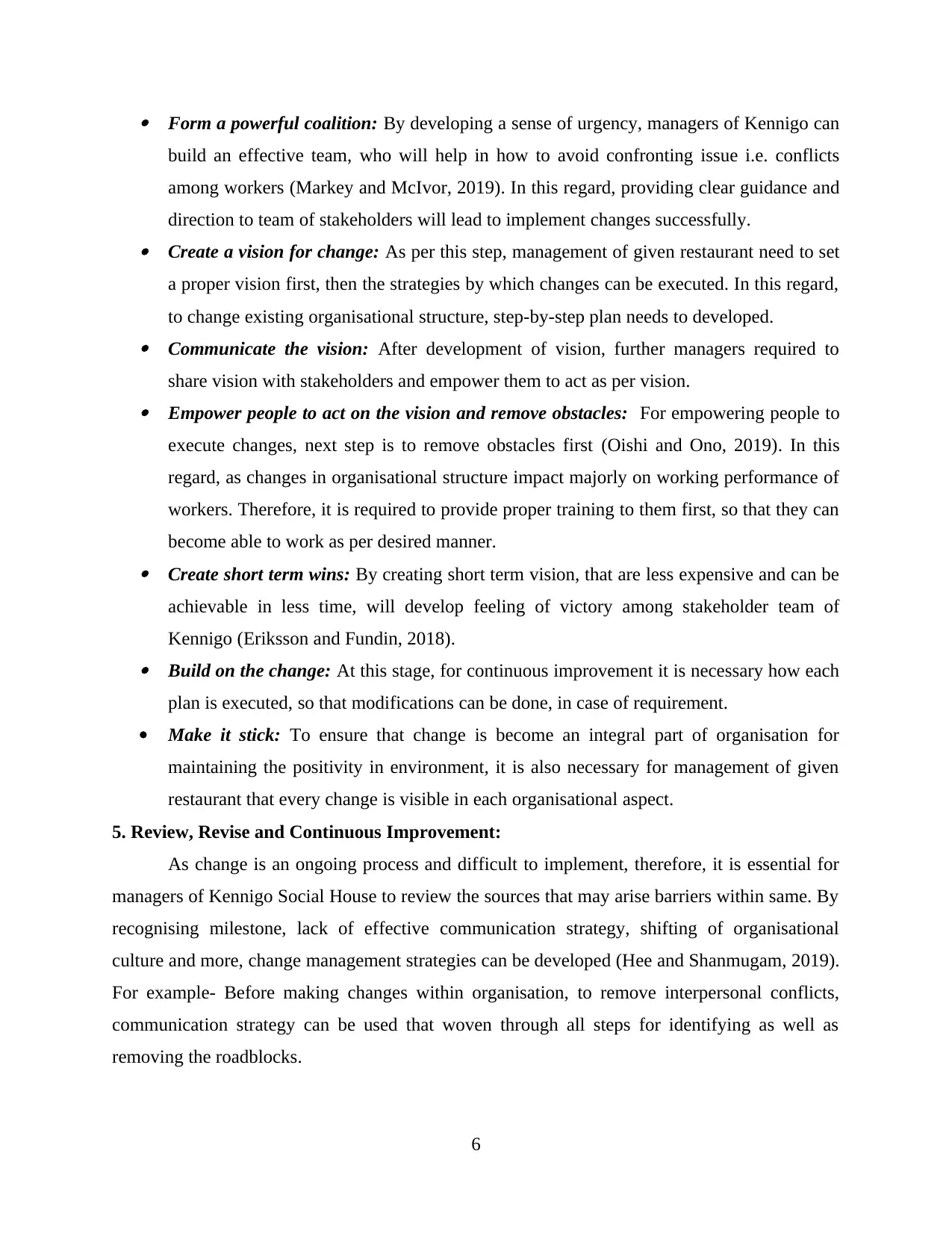
Form a powerful coalition: By developing a sense of urgency, managers of Kennigo can
build an effective team, who will help in how to avoid confronting issue i.e. conflicts
among workers (Markey and McIvor, 2019). In this regard, providing clear guidance and
direction to team of stakeholders will lead to implement changes successfully. Create a vision for change: As per this step, management of given restaurant need to set
a proper vision first, then the strategies by which changes can be executed. In this regard,
to change existing organisational structure, step-by-step plan needs to developed. Communicate the vision: After development of vision, further managers required to
share vision with stakeholders and empower them to act as per vision. Empower people to act on the vision and remove obstacles: For empowering people to
execute changes, next step is to remove obstacles first (Oishi and Ono, 2019). In this
regard, as changes in organisational structure impact majorly on working performance of
workers. Therefore, it is required to provide proper training to them first, so that they can
become able to work as per desired manner. Create short term wins: By creating short term vision, that are less expensive and can be
achievable in less time, will develop feeling of victory among stakeholder team of
Kennigo (Eriksson and Fundin, 2018). Build on the change: At this stage, for continuous improvement it is necessary how each
plan is executed, so that modifications can be done, in case of requirement.
Make it stick: To ensure that change is become an integral part of organisation for
maintaining the positivity in environment, it is also necessary for management of given
restaurant that every change is visible in each organisational aspect.
5. Review, Revise and Continuous Improvement:
As change is an ongoing process and difficult to implement, therefore, it is essential for
managers of Kennigo Social House to review the sources that may arise barriers within same. By
recognising milestone, lack of effective communication strategy, shifting of organisational
culture and more, change management strategies can be developed (Hee and Shanmugam, 2019).
For example- Before making changes within organisation, to remove interpersonal conflicts,
communication strategy can be used that woven through all steps for identifying as well as
removing the roadblocks.
6
build an effective team, who will help in how to avoid confronting issue i.e. conflicts
among workers (Markey and McIvor, 2019). In this regard, providing clear guidance and
direction to team of stakeholders will lead to implement changes successfully. Create a vision for change: As per this step, management of given restaurant need to set
a proper vision first, then the strategies by which changes can be executed. In this regard,
to change existing organisational structure, step-by-step plan needs to developed. Communicate the vision: After development of vision, further managers required to
share vision with stakeholders and empower them to act as per vision. Empower people to act on the vision and remove obstacles: For empowering people to
execute changes, next step is to remove obstacles first (Oishi and Ono, 2019). In this
regard, as changes in organisational structure impact majorly on working performance of
workers. Therefore, it is required to provide proper training to them first, so that they can
become able to work as per desired manner. Create short term wins: By creating short term vision, that are less expensive and can be
achievable in less time, will develop feeling of victory among stakeholder team of
Kennigo (Eriksson and Fundin, 2018). Build on the change: At this stage, for continuous improvement it is necessary how each
plan is executed, so that modifications can be done, in case of requirement.
Make it stick: To ensure that change is become an integral part of organisation for
maintaining the positivity in environment, it is also necessary for management of given
restaurant that every change is visible in each organisational aspect.
5. Review, Revise and Continuous Improvement:
As change is an ongoing process and difficult to implement, therefore, it is essential for
managers of Kennigo Social House to review the sources that may arise barriers within same. By
recognising milestone, lack of effective communication strategy, shifting of organisational
culture and more, change management strategies can be developed (Hee and Shanmugam, 2019).
For example- Before making changes within organisation, to remove interpersonal conflicts,
communication strategy can be used that woven through all steps for identifying as well as
removing the roadblocks.
6
⊘ This is a preview!⊘
Do you want full access?
Subscribe today to unlock all pages.

Trusted by 1+ million students worldwide
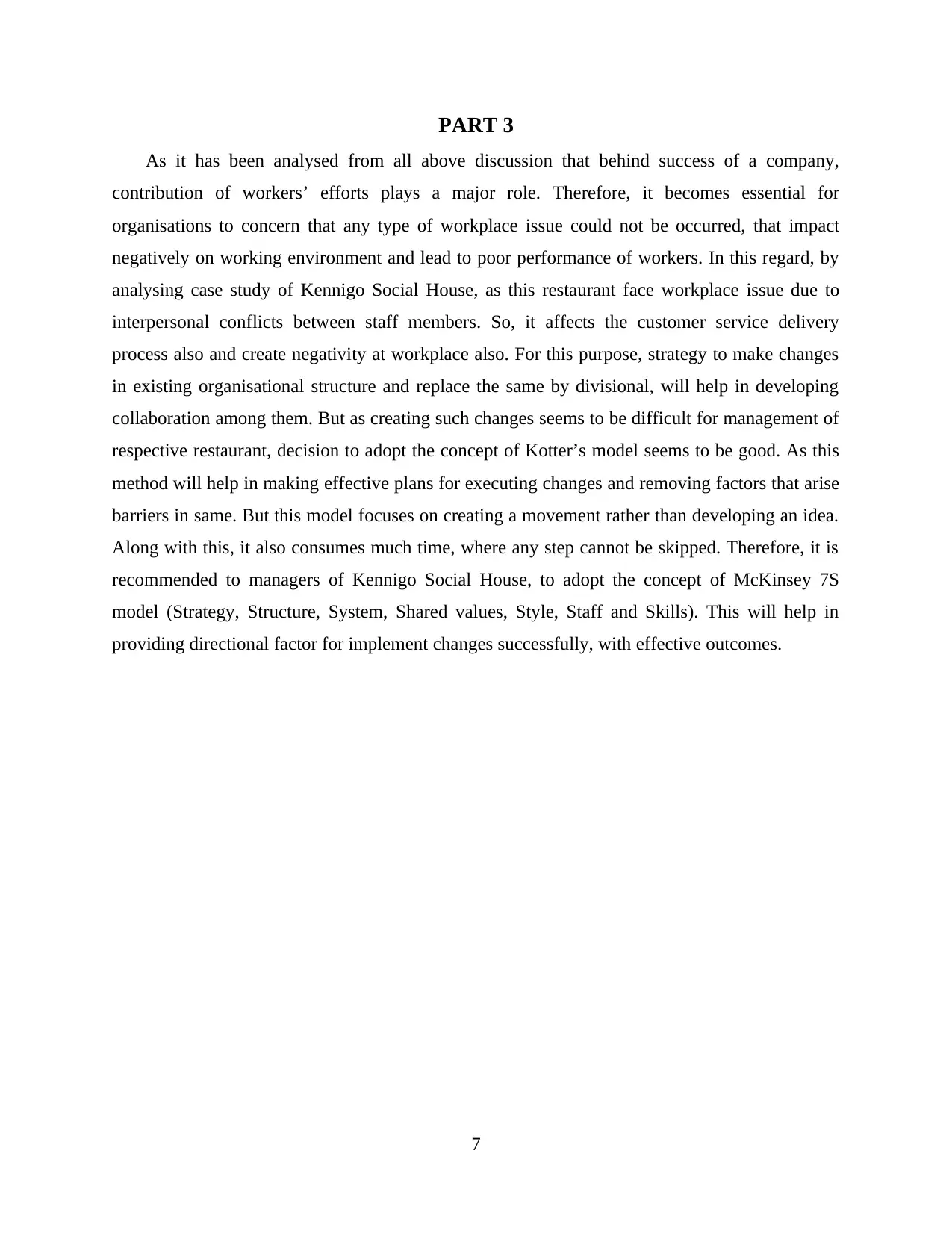
PART 3
As it has been analysed from all above discussion that behind success of a company,
contribution of workers’ efforts plays a major role. Therefore, it becomes essential for
organisations to concern that any type of workplace issue could not be occurred, that impact
negatively on working environment and lead to poor performance of workers. In this regard, by
analysing case study of Kennigo Social House, as this restaurant face workplace issue due to
interpersonal conflicts between staff members. So, it affects the customer service delivery
process also and create negativity at workplace also. For this purpose, strategy to make changes
in existing organisational structure and replace the same by divisional, will help in developing
collaboration among them. But as creating such changes seems to be difficult for management of
respective restaurant, decision to adopt the concept of Kotter’s model seems to be good. As this
method will help in making effective plans for executing changes and removing factors that arise
barriers in same. But this model focuses on creating a movement rather than developing an idea.
Along with this, it also consumes much time, where any step cannot be skipped. Therefore, it is
recommended to managers of Kennigo Social House, to adopt the concept of McKinsey 7S
model (Strategy, Structure, System, Shared values, Style, Staff and Skills). This will help in
providing directional factor for implement changes successfully, with effective outcomes.
7
As it has been analysed from all above discussion that behind success of a company,
contribution of workers’ efforts plays a major role. Therefore, it becomes essential for
organisations to concern that any type of workplace issue could not be occurred, that impact
negatively on working environment and lead to poor performance of workers. In this regard, by
analysing case study of Kennigo Social House, as this restaurant face workplace issue due to
interpersonal conflicts between staff members. So, it affects the customer service delivery
process also and create negativity at workplace also. For this purpose, strategy to make changes
in existing organisational structure and replace the same by divisional, will help in developing
collaboration among them. But as creating such changes seems to be difficult for management of
respective restaurant, decision to adopt the concept of Kotter’s model seems to be good. As this
method will help in making effective plans for executing changes and removing factors that arise
barriers in same. But this model focuses on creating a movement rather than developing an idea.
Along with this, it also consumes much time, where any step cannot be skipped. Therefore, it is
recommended to managers of Kennigo Social House, to adopt the concept of McKinsey 7S
model (Strategy, Structure, System, Shared values, Style, Staff and Skills). This will help in
providing directional factor for implement changes successfully, with effective outcomes.
7
Paraphrase This Document
Need a fresh take? Get an instant paraphrase of this document with our AI Paraphraser
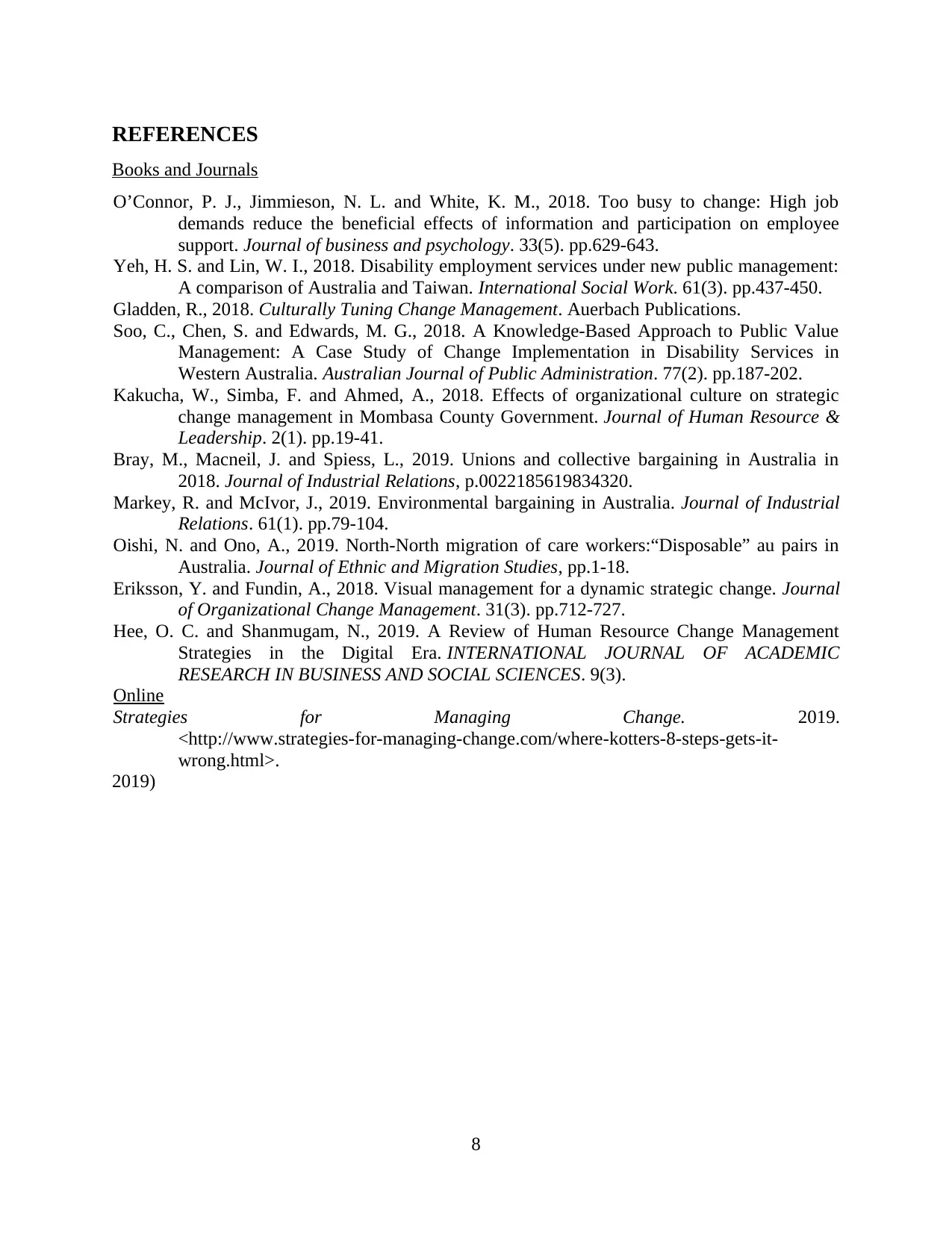
REFERENCES
Books and Journals
O’Connor, P. J., Jimmieson, N. L. and White, K. M., 2018. Too busy to change: High job
demands reduce the beneficial effects of information and participation on employee
support. Journal of business and psychology. 33(5). pp.629-643.
Yeh, H. S. and Lin, W. I., 2018. Disability employment services under new public management:
A comparison of Australia and Taiwan. International Social Work. 61(3). pp.437-450.
Gladden, R., 2018. Culturally Tuning Change Management. Auerbach Publications.
Soo, C., Chen, S. and Edwards, M. G., 2018. A Knowledge‐Based Approach to Public Value
Management: A Case Study of Change Implementation in Disability Services in
Western Australia. Australian Journal of Public Administration. 77(2). pp.187-202.
Kakucha, W., Simba, F. and Ahmed, A., 2018. Effects of organizational culture on strategic
change management in Mombasa County Government. Journal of Human Resource &
Leadership. 2(1). pp.19-41.
Bray, M., Macneil, J. and Spiess, L., 2019. Unions and collective bargaining in Australia in
2018. Journal of Industrial Relations, p.0022185619834320.
Markey, R. and McIvor, J., 2019. Environmental bargaining in Australia. Journal of Industrial
Relations. 61(1). pp.79-104.
Oishi, N. and Ono, A., 2019. North-North migration of care workers:“Disposable” au pairs in
Australia. Journal of Ethnic and Migration Studies, pp.1-18.
Eriksson, Y. and Fundin, A., 2018. Visual management for a dynamic strategic change. Journal
of Organizational Change Management. 31(3). pp.712-727.
Hee, O. C. and Shanmugam, N., 2019. A Review of Human Resource Change Management
Strategies in the Digital Era. INTERNATIONAL JOURNAL OF ACADEMIC
RESEARCH IN BUSINESS AND SOCIAL SCIENCES. 9(3).
Online
Strategies for Managing Change. 2019.
<http://www.strategies-for-managing-change.com/where-kotters-8-steps-gets-it-
wrong.html>.
2019)
8
Books and Journals
O’Connor, P. J., Jimmieson, N. L. and White, K. M., 2018. Too busy to change: High job
demands reduce the beneficial effects of information and participation on employee
support. Journal of business and psychology. 33(5). pp.629-643.
Yeh, H. S. and Lin, W. I., 2018. Disability employment services under new public management:
A comparison of Australia and Taiwan. International Social Work. 61(3). pp.437-450.
Gladden, R., 2018. Culturally Tuning Change Management. Auerbach Publications.
Soo, C., Chen, S. and Edwards, M. G., 2018. A Knowledge‐Based Approach to Public Value
Management: A Case Study of Change Implementation in Disability Services in
Western Australia. Australian Journal of Public Administration. 77(2). pp.187-202.
Kakucha, W., Simba, F. and Ahmed, A., 2018. Effects of organizational culture on strategic
change management in Mombasa County Government. Journal of Human Resource &
Leadership. 2(1). pp.19-41.
Bray, M., Macneil, J. and Spiess, L., 2019. Unions and collective bargaining in Australia in
2018. Journal of Industrial Relations, p.0022185619834320.
Markey, R. and McIvor, J., 2019. Environmental bargaining in Australia. Journal of Industrial
Relations. 61(1). pp.79-104.
Oishi, N. and Ono, A., 2019. North-North migration of care workers:“Disposable” au pairs in
Australia. Journal of Ethnic and Migration Studies, pp.1-18.
Eriksson, Y. and Fundin, A., 2018. Visual management for a dynamic strategic change. Journal
of Organizational Change Management. 31(3). pp.712-727.
Hee, O. C. and Shanmugam, N., 2019. A Review of Human Resource Change Management
Strategies in the Digital Era. INTERNATIONAL JOURNAL OF ACADEMIC
RESEARCH IN BUSINESS AND SOCIAL SCIENCES. 9(3).
Online
Strategies for Managing Change. 2019.
<http://www.strategies-for-managing-change.com/where-kotters-8-steps-gets-it-
wrong.html>.
2019)
8
1 out of 11
Related Documents
Your All-in-One AI-Powered Toolkit for Academic Success.
+13062052269
info@desklib.com
Available 24*7 on WhatsApp / Email
![[object Object]](/_next/static/media/star-bottom.7253800d.svg)
Unlock your academic potential
Copyright © 2020–2025 A2Z Services. All Rights Reserved. Developed and managed by ZUCOL.





